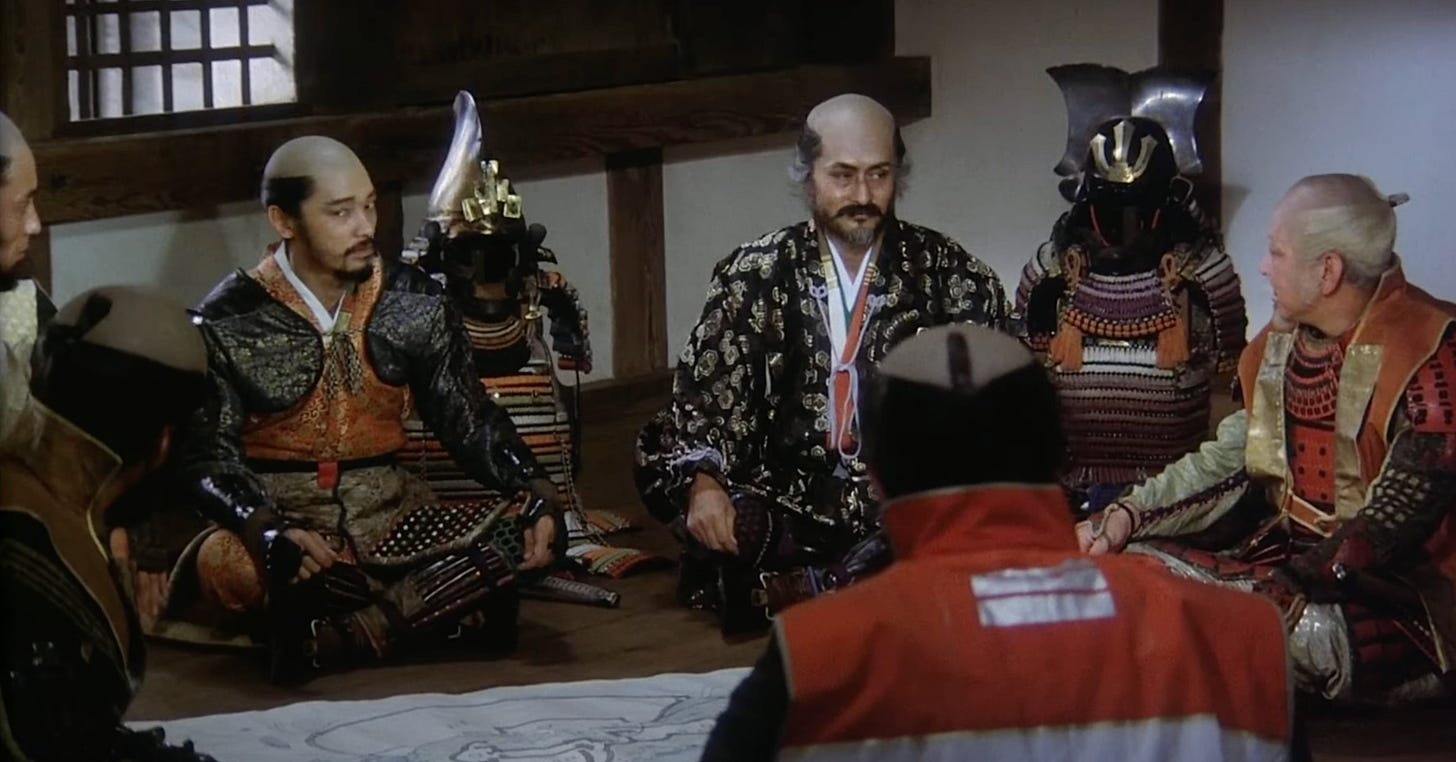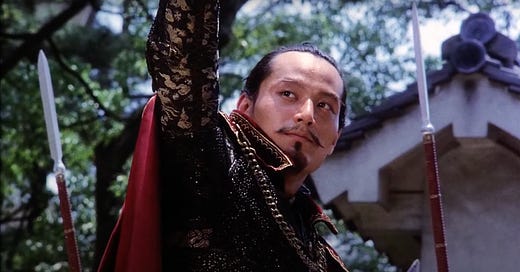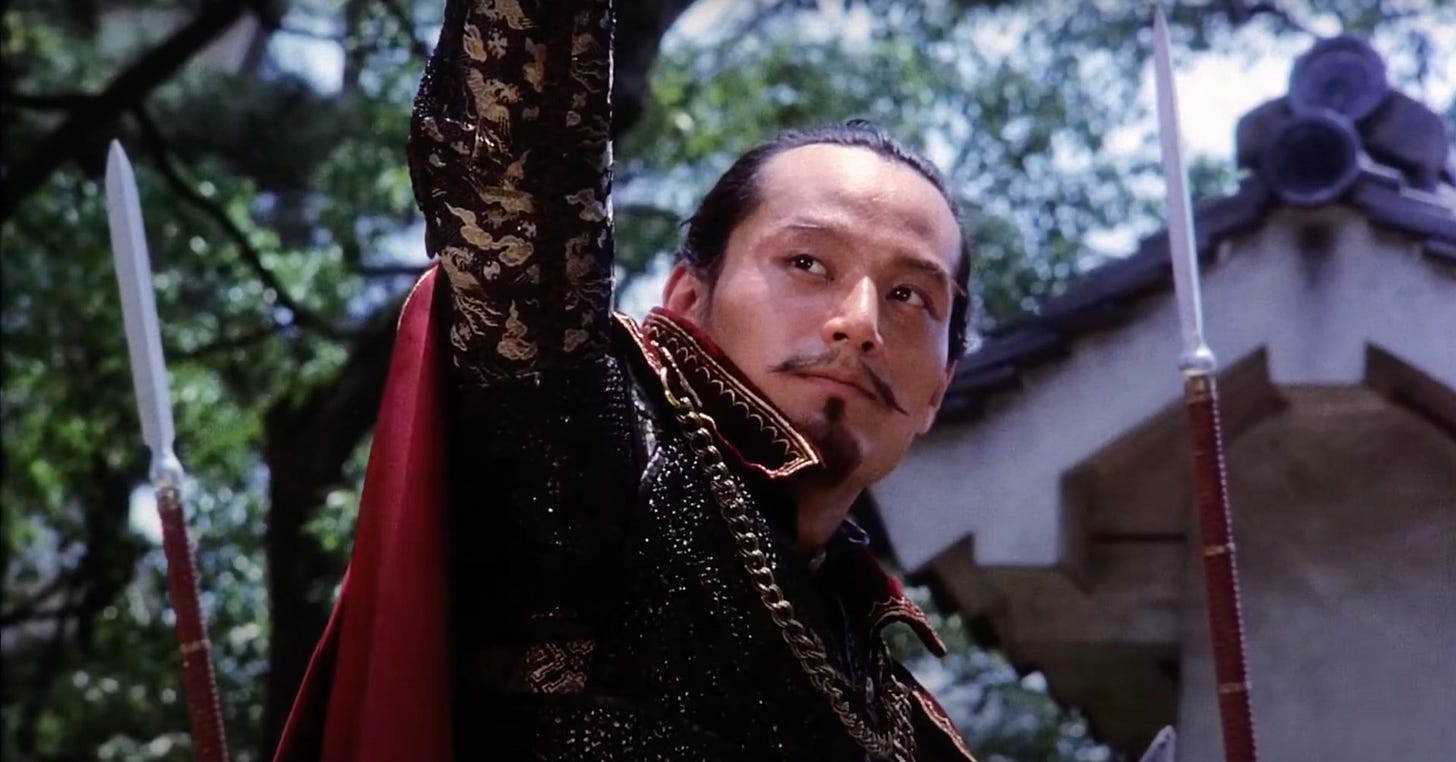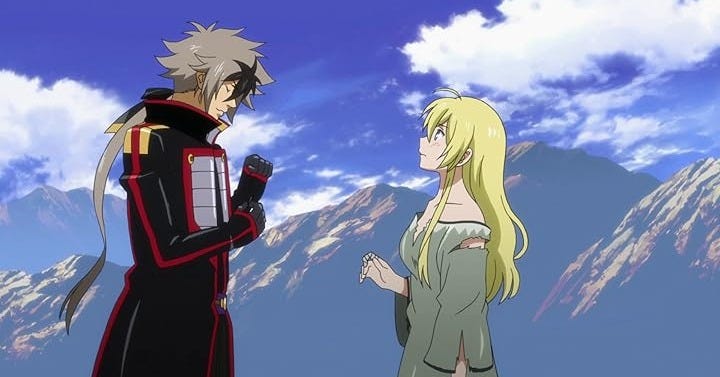*But is it medieval? A brief disclaimer
Medieval-ish, yes. To put on my professor hat for a minute, while “medieval” has a Eurocentric connotation (the middle ages are in the “middle” of Roman civilization and the Renaissance, whatever that is, c. 500-c. 1500), the definition can include other cultures in useful ways. Scholars have spilt much ink over whether “medieval” is the right word to use when referring to non-western history, but for my purposes, it counts (same goes for the 1980 Shōgun miniseries, which I will review in a few weeks). When scholars refer to “medieval” Japan they usually mean the feudal Japan of the Sengoku period which lasted from 1336 until the beginning of the Tokugawa shogunate in 1603.1 In this society, a warrior elite, daimyō or regional lords, collected taxes, kept what peace there was, and commanded armies of samurai against one another. Towards the end of the period, with the advent of Portuguese traders and Jesuits, that society observed, selectively adopted, and then largely expelled western innovations, from Christianity to matchlock firearms, all of which is featured in Akira Kurosawa’s Kagemusha (1980).
Synopsis and Background
In 1573, the daimyō Takeda Shingen (Tatsuya Nakadai) employs a kagemusha — a double or “shadow warrior” — a common thief (also Nakadai) who looks just like him. Mortally injured by a sniper, Shingen swears his brother Nobukado (Tsutomo Yamazaki) and his chief retainers to secrecy, commanding them to use the double to keep his enemies in the dark. The kagemusha first struggles against, and later comes to embrace, his identity as Shingen, and even after his unmasking remains loyal to the Takeda clan until his death at the historical Battle of Nagashino (1575).
For a film buff I haven’t seen that many Kurosawa films, and was more familiar with his “classic” work from the ‘50s and ‘60s. Yojimbo (1961) and Sanjuro (1962) were my favorites, driven by the winning combination of comic timing and homicidal mayhem in star Toshiro Mifune’s performance as a masterless samurai.
Kagemusha feels very different from that body of work. Hailed at the time as Kurosawa’s return to the samurai genre, it’s not really a samurai film: combat, especially hand-to-hand combat, is de-emphasized and much of the action happens off screen, leaving audiences expecting another Seven Samurai disappointed. As critics note, the film maintains a deliberate, cold distance from its characters and events. Vincent Canby called the film ritualistic, and Donald Richie likened it to opera, calling it “a self-conscious, noble, and hopeless picture.”2 Not exactly a ringing endorsement? But Roger Ebert gave it four stars; it won the Palm D’Or at Cannes in 1980; and I liked it too.3
Impostors, Performers, Directors

Kurosawa was reportedly inspired to make Kagemusha after reading that the historical Shingen had used a double, and he was also puzzled about how the Takeda clan were massacred so completely while their enemies at Nagashino remained unscathed.4 He had planned the film over several difficult years, struggling to find financial backing from his usual studio, Toho, after his last Japanese film, Dodes’ka-den (1970), flopped, and during which he was dealing with health issues and even attempted suicide.5 Ultimately Francis Ford Coppola and George Lucas (uber fans whose work Kurosawa deeply influenced) were instrumental in the film becoming a reality and are listed as executive producers of the international version. What resulted was a visually beautiful, though supremely depressing, epic about the slippery nature of identity.
Kurosawa wrote the script with famed comic actor Shintaro Katsu in mind for the lead, but they fell out dramatically soon after production started, and Tatsuya Nakadai took the role instead. Nakadai had worked with Kurosawa before, but his subdued performance as the kagemusha left most critics cold. To me, Nakadai’s performance feels quieter and more fragile than Katsu’s might have been, but the contrast Kurosawa presents between the kagemusha as Shingen in epic battle scenes, immovable or heroic on a horse, and the pathetic reality of Nakadai’s thief is very effective.

In the opening scene the thief berates Shingen for being more vicious than he, but he eventually comes to idolize and serve him. Throughout, the audience doesn’t see a man struggling against himself so much as a man struggling with an impossible task - the thief’s personality is oddly, I think deliberately, blank, and it’s hard to imagine Katsu repressing himself to this extent. Further, Kurosawa seems to imply that all lords are kagemusha in some way. Empty sets of armor, a fixture of the audience chamber, are placed strategically throughout the film behind various lords (Nobunaga even has two - a Japanese and a western set). There’s already a shadow warrior behind each of them, a tool and a symbol all in one.
What struck me, though, was how both Shingen and the kagemusha chase and run away from the thing they want most, though there’s pointedly no insight into why they want those things. After his injury, Shingen decides to retreat from Kyoto, even though Kyoto is what he wants most of all — he dies screaming, reaching out for it even as he’s traveling away. In a hallucinogenic dream sequence, the thief comes face to face with the phantom Shingen, first running in fear, and then chasing as soon as he turns away. And just as he finally gives his life for the Takeda clan, the camera pans over the empty stools the Takeda leaders have vacated - there’s no one there to see him, and he’s too late. I guess the trick is running toward the thing you want at the right time.
Some critics, like Audie Bock and Stephen Prince, read Kagemusha as autobiographical, a cathartic telling of Kurosawa’s “expulsion” from the Japanese film industry, fomenting over the miserable five years he spent planning it. Reading the thief, and his ability to manipulate the image, as a double for Kurosawa himself, Prince suggests that the film then becomes “wish-fulfilling revenge fantasy” as the Takeda face destruction after expelling the thief.6 This feels a little too on the nose for me, given the many levels on which all of Kurosawa’s films function, but this reading makes it even more interesting to consider who was coming to replace the Takeda, at least for awhile: Shingen’s enemy, Oda Nobunaga.
Nobunaga the “Heretic”
Kurosawa was fascinated with Nobunaga, characterizing him in an interview as
“…a genius, a much more ‘modern’ man than the average Japanese of that time. According to [Luís Froís, a Portuguese Jesuit confidant of Nobunaga’s], Nobunaga knew that the earth was round, and was well informed about the world situation. He was also an active importer of new objects and ideas from abroad. That was the sort of personality that defeated the Takeda Clan.”7
Throughout the film, Kurosawa emphasizes Nobunaga’s use of western innovation: beyond the massed firearms that win him Nagashino, there’s his enjoyment of European wine; his frequent use of western clothing alongside traditional Japanese; his toleration and strategic deployment of the Jesuits; even a suit of western armor. He’s a savvy operator, and above all a skeptic who never quite buys that Shingen is still alive.
Though Nobunaga is pushed from the center of action in Kagemusha, then-unknown, 23-year-old Ryu Daisuke manages to steal the few scenes he’s in, a dashing presence set apart by his hybrid western-Japanese wardrobe (it also doesn’t hurt that at 6’2” he towers over most of the other actors). Historians paint Nobunaga as a ruthless warlord and an unpredictable character who often behaved in outrageous or inappropriate ways.8 He died by seppuku in 1582, outmaneuvered by one of his vassals, but he is remembered as one of Japan’s three unifiers, along with Toyotomi Hideyoshi and Ieyasu Tokugawa.

In an arresting scene just before the final battle, as he is informed of Shingen’s death, Nobunaga performs part of Atsumori, a Noh play. It’s the song of a reluctant killer and a meditation on the evanescence of human life. While the film’s Nobunaga is an anti-traditionalist, here he adopts a highly structured, very traditional form and steps out of himself (it’s also the only time in the film he wears fully traditional Japanese garb), altering his natural gestures and tone of voice to express his anger? regret? at the reality of Shingen’s death. The message seems to be the flip side of the thief’s futile attempt to be Shingen: some things you can only express (or do or be) as someone else, if only for a little while.
In western popular culture, Nobunaga probably has the most name recognition of any character in Kagemusha due to his video game incarnations, first in Koei’s long running Nobunaga’s Ambition series (16 titles 1983-present), and most recently in Ubisoft’s samurai-themed Assassin’s Creed: Shadows (2025) one of whose protagonists starts out in his service.
But what really blows my mind as a medievalist is Nobunaga the Fool (Shōji Kawamori, 2014). This anime series puts Nobunaga in space, the “Heretic of the Eastern Star,” exiled and derided for his unorthodox ways, fighting his way back to his rightful legacy with the help of an overpowered mech-suit that he names “The Fool” and his love interest, none other than the “Heretic of the Western Star,” Joan of Arc (seriously). The series also includes a villainous collection of ancient/medieval figures from the Western Star (Charlemagne! Cesare Borgia! King Arthur! Julius Caesar!) on their tail. This pairing maybe isn’t as random as it seems; Nobunaga and Joan both bucked tradition and died young; defeated, but remembered as heroic, if tragic, legends who rose to greatness, even if only to fall. If I ever make it out of the 1980s, I’d love to unpack all this.
So, if the kagemusha is a stand in for Kurosawa, who or what is Nobunaga? The future, and a pragmatic embrace of western techniques and style turned to his own purpose? Or something more than that? His eventual downfall feels very far away from the action of Kagemusha. So what hope there is in this film, I think, belongs to him.
For an accessible spot to wade into the scholarly conversation on the Global Middle Ages, see Peter Frankopan, “Why We Need to Think About the Global Middle Ages,” The Medieval World 1.1 (2019): 1-5. For an overview of the period, see Brett L. Walker, A Concise History of Japan (Cambridge, 2015), Ch. 4 “Medieval Japan and the Warring States Period, 1336-1573,” pp. 66-82; Ch. 5 “Japan’s Encounter with Europe, 1543-1640,” pp. 83-101; and Ch. 6 “Unifying the Realm, 1560-1603,” pp. 102-123.
Vincent Canby, “Kagemusha: Kurosawa’s 27th Film” The New York Times October 6, 1980; Donald Richie, The Films of Akira Kurosawa 3rd ed. (Berkeley, 1996), 213.
Richie, 207. Interview with Kurosawa in Tony Rayns, “Tokyo Stories,” Sight and Sound 50 (Summer 1981): 170-176.
In the interim he also made Dersu Uzala (1975) with Soviet financial backing, his only non-Japanese-language film.
Stephen Prince, The Warrior’s Camera: The Cinema of Akira Kurosawa (rev. ed., Princeton, 1999), 278; Audie Bock, “Kurosawa: His Life and Art,” in Rashomon ed. Donald Richie (Rutgers, 1987), pp. 23-25.
Rayns, qtd. in Prince, 274.
See Walker, 103-4. I didn’t get a chance to read Jeroen Lamers, Japonius Tyrannus: The Japanese Warlord Oda Nobunaga Reconsidered (Leiden, 2000).






